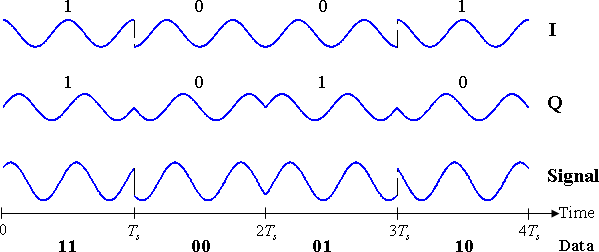stumbled upon QPSK (quadrature phase-shift keying) which apparently is the/a method used to transmit data in WiFi...
This looks, actually, quite similar to my earlier rambling thoughts on using anaQuad as a data-transmission method.
Some key (hah) points:
QPSK, since it's tied to RF signals, relies on a phase-shift that's maintained for *numerous* cycles (the carrier wave), whereas anaQuad uses two separate wires, and no carrier frequency, so phase-shifts can be easily detected several times *within* a cycle.
While this may make the two seem quite different, I think both techniques are quite similar in concept, owing most of their differences to their medium.
Also QPSK allows for *two* bits to be transmitted simultaneously... one for each phase in the quadrature signal. Whereas my earlier thoughts for anaQuad only transmits one.

(QPSK, Wikipedia)
There's good reason. QPSK can allow for signal changes with discrete jumps, each bit-encoding is independent of the previous. The same could be done with anaQuad, plausibly allowing up to 16 or more values (4 bits) to be encoded in each ... thing. (Phase-shift, maybe. Or key?)
My earlier ramblings on anaQuad used as data-transmission explicitly removed the ability for sudden jumps in the signal. Thus, one bit is encoded into each "key" dependent on whether there's a positive phase-change or negative. (Plausibly trinary, considering no-change). Thus, each bit-value's representation (as viewed as a waveform) is entirely dependent on the previous.
Now, I'm not certain I read this correctly, but I think I saw mention that QPSK, or some derivation, is sometimes used similarly.
My reasoning: transmission-lines and slew rates. Sudden changes have slew rates to take into account... transmission lines can *smooth* a sharp edge by the time it reaches a receiver. Also, the receiver itself has slew-rates, the transistors don't switch *immediately*... and... anaQuad pushes those switching-speeds by working with smaller/slower changes (and linear regions).
But... if that somewhat arbitrary limitation was removed, and if the technique was transmitted over a carrier-wave, instead of two wires (and a separate clock? Probably only necessary in the trinary case)... and if it were cut down to only four phases (actually, it seems there are QPSK-derivatives that have more), it would seem the ramblings on using anaQuad for data transmission are... darn-near exactly the same as QPSK, of which I had no prior knowledge.
Yay!
A particularly interesting-to-me learning from QPSK is how the quadrature signals are combined into one... at any instant, except during a phase-change, the signal appears to be nothing but the carrier frequency. So detecting the phase change must require the receiver to have a duplicate of the unshifted carrier-wave running somewhere to compare to... Not dissimilar to how an LVDS receiver uses a PLL to recreate the bit-clock, or how a floppy drive synchronizes an internal clock to clock-pulses on the diskette which are *not* alongside *every* bit.
Not sure how/if to use that with anaQuad... in the two-wire, single-bit, method, clocking is inherent with the bit-phase-transitions. OTOH, it requires two wires.
Mathematically, knowing the two "wire" phases are always quadrature, is it possible to use superposition to combine them on a single wire, still extract the two signals to gain the benefits of "crossover-detection" (noise/source-calibration immunity, mainly) and have inherent-clocking? Sounds like a tall order. But... hmmm....
 Eric Hertz
Eric Hertz
Discussions
Become a Hackaday.io Member
Create an account to leave a comment. Already have an account? Log In.